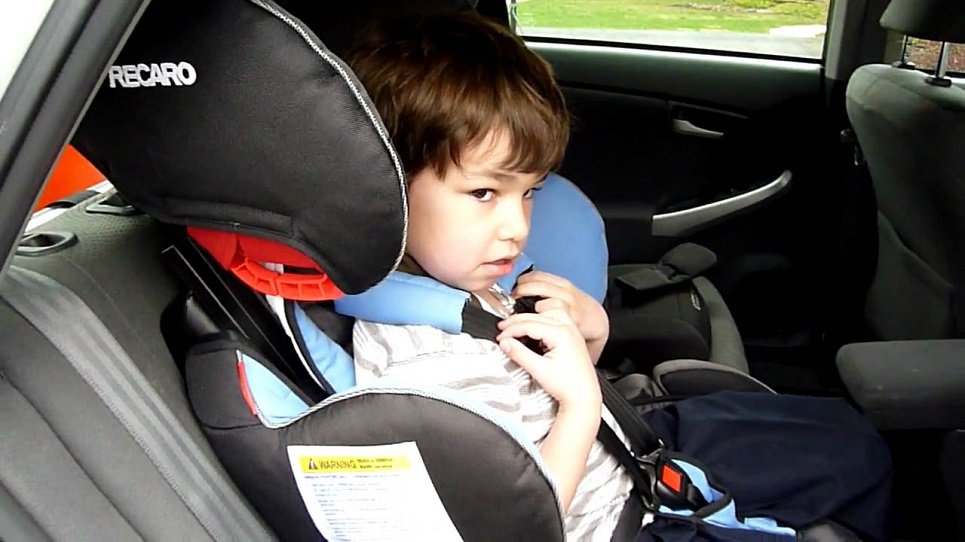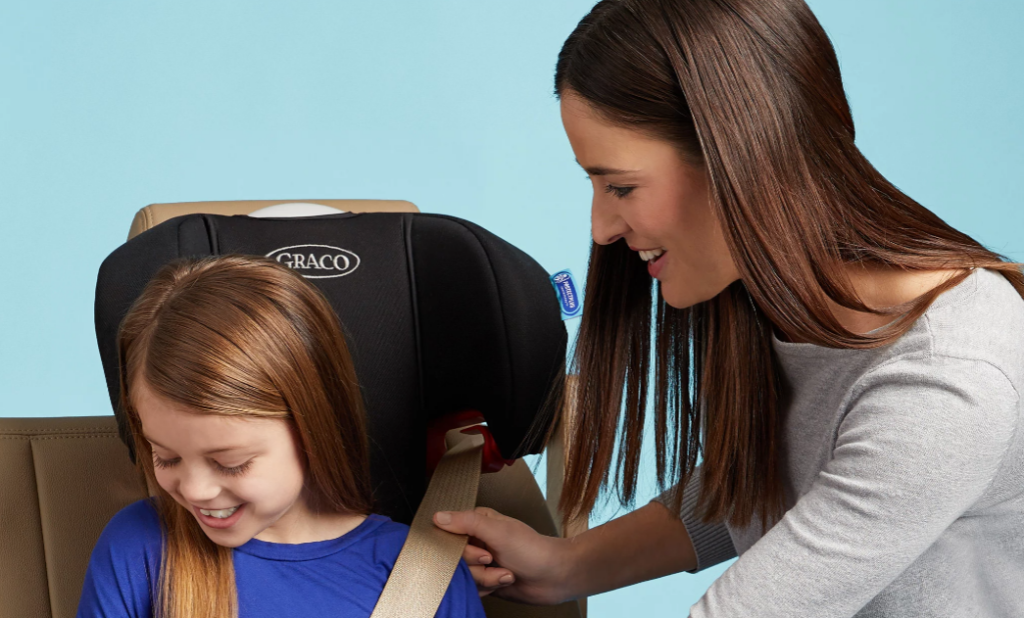- Car Seat Expiration Guide - November 4, 2022
- Best Britax Car Seats Guide - October 30, 2022
- Front Facing Car Seat Age Guide - October 29, 2022
State laws only specify the minimum requirements a child must meet to ride in the forward-facing position. From a legal standpoint, parents in most states can start using front-facing car seats after their child’s first birthday.
Safety recommendations issued by the American Association of Pediatrics and the National Highway Traffic Safety Administration suggest that toddlers under three should remain in rear-facing seats until they outgrow their height and weight limits.
Statistics show that toddlers and preschoolers are less likely to sustain head or spine injuries when riding in a rear-facing position. The discrepancy between the car seat laws and the best safety practices makes choosing the right moment to switch to the forward-facing position difficult.
In this front-facing car seat age guide, I’ll supply the facts that will help you move safely from an infant car seat to a front-facing model.

Table of Contents
- 1 Bottom Line Up Front
- 2 What’s a Front-Facing Car Seat?
- 3 Front-Facing Car Seat Types
- 4 Height and Weight Limits
- 5 LATCH System, Harness Systems, and Safety Features
- 6 Replacement Guidelines and Expiration Dates
- 7 Cost and Warranty
- 8 Best Front-Facing Car Seat Recommendations
- 9 Nuna Revv Convertible Car Seat – The best high-end front-facing car seat option
- 10 Diono Radian 3QX – Best for Families with Two or More Children
- 11 Chicco NextFit Zip – The Best Convertible Car Seat
- 12 Britax Grow with You Harness-to-Booster – Best for School-Aged Children
- 13 Maxi-Cosi Pria – The best budget-friendly front-facing car seat
- 14 FAQs
- 15 Front Facing Car Seat Age Guide: Final Thoughts
Bottom Line Up Front
Following the seat manufacturer’s instructions is the easiest way to ensure your little one receives the maximum level of protection and remains compliant with the state’s car seat laws. Brands commonly recommend different front-facing car seat types for kids older than three, although some models are suitable for two-year-olds.
More importantly, a child must meet the front-facing seat’s minimum height and weight requirements before he or she can start using it.
| Recommended age | Transition period | Maximum weight | Maximum Height |
| 2 – 7 years | 1 – 3 years | 40 to 120lbs | 30 to 49 inches |
What’s a Front-Facing Car Seat?
Any child safety seat that can be installed in the forward-facing position can be considered a front-facing car seat. All car seat types, except the rear-facing only infant car seats, can serve as front-facing seats.
However, some models are designed to support children from birth until they’re old enough to use a vehicle’s seat belt system, which blurs the lines between front-facing car seat types. This also complicates the process of choosing a car seat based solely on the child’s age.
As I already pointed out, the nation’s leading child passenger safety authorities no longer publish car seat recommendations based on the child’s age. Instead, they emphasize the child’s weight and height as key parameters parents should follow when choosing an appropriate riding position for their child.
For instance, the Florida car seat law allows children aged six or older to ride in regular car seats, so drivers are under no obligation to use a booster or other types of safety seats when transporting school-age children. Still, a child in this age group may not be tall enough or have the necessary weight to use the vehicle’s seat belt, which can expose it to unnecessary danger if an accident occurs.

Front-Facing Car Seat Types
According to the NHTSA’s classification, there are three types of front-facing seats. Interestingly, booster seats are a separate category even though they can only be installed in the forward-facing position. The same organization indicates that front-facing car seats are suitable for kids aged seven or younger.
Let’s go through the main characteristics of front-facing car seat types:
- Convertible – These models have rear and front-facing modes. Each mode has a weight and height limit, which makes transitioning between riding positions easier. However, most children outgrow convertible car seats at the age of four.
- Harness-to-booster – Combination or harness-to-booster seats accommodate kids aged four to nine and allow them to transition slowly from a five-point harness to the car’s seat belt. Besides a harness, these seats are equipped with tethers that enable you to attach them to the vehicle’s tether anchor.
- All-in-one – Instead of buying a new car seat every few years, you can get an all-in-one model that adjusts to your child’s needs as it grows. In addition, most all-in-one car seats combine the features provided by convertible and combination models.
Height and Weight Limits
Children don’t grow at the same pace, which is why age can only serve as a vague guideline. Hence, it’s necessary to consider your child’s current weight and height when selecting a front-facing car seat.
Convertible models are an excellent choice for newborns as their minimum weight limit is 5lbs, and parents can continue using them in the rear-facing mode as long as the child weighs less than 40lbs or outgrows the 40-inch height limit.
Front-facing modes of convertible models usually have a 65lbs weight and 49-inch height limits. Harness-to-booster seats are designed for children that currently weigh more than 25lbs, and they’re suitable for all kids under 100lbs of weight or children shorter than 54 inches.
All-in-One models have height and weight limits for each mode, and their maximum weight limit is around 120lbs. Hence, most children can use an all-in-one car seat until they turn 12.
LATCH System, Harness Systems, and Safety Features
LATCH, or lower anchors and tethers, is one of the first terms I encountered when I started searching for a front-facing car seat. This term simply indicates which types of connectors are used during the installation.
These systems contain a pair of lower straps that attach to anchors on the vehicle’s back seat and a tether strap usually located at the top of the safety seat. Nearly all cars and front-facing car seats produced from 2002 onward are equipped with LATCH systems, but you should remember that some brands utilize different seat installation systems.
It’s worth adding that most front-facing car seats, except booster seats that utilize the vehicle’s belt, have five-point harnesses, and you should avoid models with three-point harnesses. Shock-absorbing bases, additional padding in the chest and head areas, and leveling systems are some of the essential safety features a front-facing car seat should have.

Replacement Guidelines and Expiration Dates
Brands and child passenger safety institutions like NHTSA recommend replacing car seat models after an accident. This recommendation applies to moderate or serious accidents that result in considerable damage to the vehicle’s exterior or interior.
NHTSA also outlines the circumstances under which replacing a front-facing car seat is unnecessary. So, you don’t have to get a new safety seat if all passengers were unharmed in the accident, and you could drive your vehicle away from the site of the accident.
I don’t think buying a second-hand front-facing car seat is a good idea because there are no federal or state regulations that prohibit the sale of expired models. Convertible, harness-to-booster, and all-in-one car seats expire after six to ten years because their safety features start to deteriorate. Also, AAP advises against using models that don’t have expiry dates for more than six years.
Cost and Warranty
Front-facing car seats can be expensive, as some models cost more than $600. However, medium-range options are available for $300 to $500. That’s why opting for a convertible model like Graco My Ride 65 LX isn’t the most affordable solution since you’ll have to replace it after three to four years.
Despite their high upfront cost, all-in-one front-facing car seats offer the best value for the money because you won’t have to replace them every few years. The duration of the seat’s warranty period will depend on the brand you choose.
Companies like Maxi-Cosi or Britax offer one-year warranties for their models, while registered Chicco car seats have limited three-year warranties. However, most companies don’t offer a replacement if the seat is damaged in an accident.
Best Front-Facing Car Seat Recommendations
Nuna Revv Convertible Car Seat – The best high-end front-facing car seat option

To say that I was impressed with Nuna Revv Convertible Car Seat’s features when I discovered this model would be an understatement. I fell in love with the combination of comfort, functionality, and safety the seat delivers.
The seat rotates for 360-degrees enabling you to switch between rear-facing and forward-facing positions as you see fit. A steel frame, an anti-rebound bar, EPP foam, and Aeroflex side impact protection are among the features that guarantee the child’s safety.
Moreover, the seat has five back recline positions, a five-point harness system, and Merino wool inserts that ensure the child is safe and comfortable.
Pros
- Parents can detach the seat from the base
- This model has a Greenguard Gold certificate
- The seat has a multi-positional headrest
- It has a sturdy frame
Cons
- This model doesn’t have LATCH
- It’s not suitable for kids taller than 43 inches
Diono Radian 3QX – Best for Families with Two or More Children

Installing two or three safety seats on your car’s backseat can be quite a conundrum, but opting for a narrow model like the Diono Radian 3QX can make this process easier. This all-in-one seat can last for ten years, and you can use it in rear-facing or forward-facing positions.
What’s more, its rear-facing weight limit is 50lbs, which allows you to use it in this position for more than two years. The seat’s equipped with Diono’s SuperLATCH system that prevents it from moving for more than an inch in either direction.
Radian 3QX has six layers of side impact protection, a five-point harness, and other safety features that can help avert serious injury. Please take a look at our Diono Radian vs. Rainier comparison to learn more about these car seat models.
Pros
- Suitable for three-across car seat setups
- It replaces high-back booster seats
- It doesn’t contain flimsy plastic parts
- It has excellent safety features
Cons
- The seat’s back isn’t adjustable
- Cleaning the seat is difficult
Chicco NextFit Zip – The Best Convertible Car Seat

Unlike the brand’s rear-facing only infant seats, the Chicco NextFit Zip cannot double as a carrier. It doesn’t have an anti-rebound bar or a carrying handle, so moving it between cars can be difficult. This is arguably the only NextFit Zip’s noteworthy downside.
The convertible car seat is suitable for children up to 40lbs in the rear-facing mode or 65lbs in the front-facing mode. It also has LATCH connectors, straps, a LockSure belt system, and a chinch tightener, so installing the seat in either position doesn’t take much effort.
The DuoGuard protection system includes two layers of shock-absorbing foam in the head and torso sections, as well as a steel frame. Please read our Chicco NextFit Zip review for a more detailed view of this convertible car seat.
Pros
- The seat has an integrated leveling system
- All fabrics are removable and machine-washable
- The harness doesn’t contain chemicals
- The seat expires after eight years
Cons
- This Chicco model doesn’t have an anti-rebound bar
- The seat weighs 25lbs
Britax Grow with You Harness-to-Booster – Best for School-Aged Children

The list of Britax Grow with You Harness-to-Booster’s features might seem underwhelming until you realize that this model expires after nine years and it has multiple layers of side impact protection.
In addition, the seat’s base is equipped with SafeCell technology that absorbs the force from an impact and protects the child during a crash. The Britax’s ClickTight installation method doesn’t employ LATCH connectors, but it still keeps the seat firmly in place.
The seat has an adjustable harness with 12-inches to 20-inches slot heights, and it allows you to use the vehicle’s lap and shoulder belts in booster mode.
Pros
- The seat’s fabric is breathable and moisture-resistant
- It has a steel tensioner that automatically fastens the seat
- The seat’s five-point harness can be stored once the child stops using it
- It can accommodate children that weigh up to 120lbs
Cons
- It’s more expensive than its competitors
- The seat doesn’t use the LATCH system
Maxi-Cosi Pria – The best budget-friendly front-facing car seat

Spending hundreds of dollars on car seats you’ll have to replace after a few years isn’t the best way to spend your money. Instead, I think getting a front-facing car seat like the Maxi-Cosi Pria is a much better option because your child can use it for ten years.
The 3-in-1 seat has rear, front, and booster modes, so kids can use it from their birth until they reach its 100lbs weight limit. This Maxi-Cosi model utilizes the LATCH system and is equipped with a tether at the top. The brand recalled the versions of this seat with 70lbs and 85lbs weight limits due to concerns related to its capability to prevent head injury when used without the top tether.
Pros
- It utilizes GCell side protection technology
- The seat is elegant and functional
- This model has QuickClip magnetic buckling mechanism
- It has two cup holders
Cons
- The seat is bulky, and it’s not an ideal fit for all cars
- Leveling the seat can be difficult
FAQs
Question: What are the Most Common Issues with Front Facing Car Seats?
Answer: The most common problems with these seats are defective buckles, insufficient padding, and flimsy plastic components.
Question: Do All Front Facing Car Seats Have Machine-washable Covers?
Answer: Models produced by Chicco, Britax, or Nuna have machine-washable covers, but some brands offer car seats that can only be spot cleaned.
Question: Are Front-Facing Car Seats Heavy?
Answer: The average weight of a front-facing car seat varies from 20lbs to 30lbs, but despite this moving them from one car to another can be difficult.
Front Facing Car Seat Age Guide: Final Thoughts
The ongoing debate about the right moment to switch to a front-facing car seat is caused by the differences between what the experts are saying and the legal requirements. My opinion is that placing a child in the forward-facing position at the age of two, as the law suggests, is simply too early.
Manufacturers offer a solution to this problem by recommending switching to a front-facing model when a child outgrows its infant seat. Convertible and all-in-one seats allow parents to monitor their child’s growth and pick the best moment to switch from one mode to another.
Combination seats help a child transition gradually from the seat’s harness system to the vehicle’s seat belt. So, ideally, a child shouldn’t start using a front-facing seat before it turns three, and it should switch to a booster seat around its seventh birthday or when it weighs over 65lbs.



